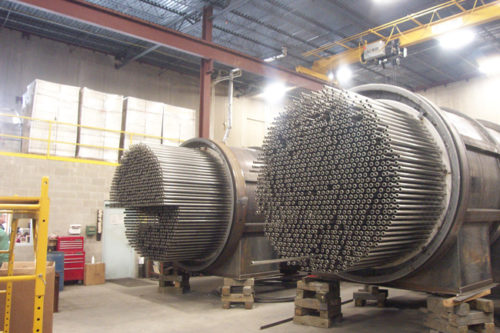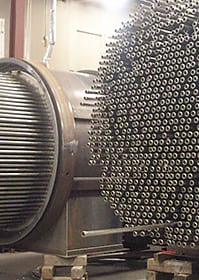Pros and Cons of Air-to-Air Heat Exchangers
Leave a CommentAir-to-air heat exchangers are common in a variety of diverse industries for effectively carrying out heat transfer and recovering wasted heat from exhaust air for use in other equipment. Managing thermal energy is particularly important for technological, power, and other utility installations, though it has specific benefits and drawbacks to consider for any application. Before integrating an air-to-air heat exchanger into your systems, learn more about this equipment and its ideal uses.
What Are Air-to-Air Heat Exchangers?
When energy transfers from one piece of equipment to another, or even from one kind of energy to another, at least a portion of that energy transitions to heat. Air-to-air heat exchangers enable the transfer of thermal energy, exchanging heat between a minimum of two environments of different temperatures. These exchangers use a working fluid like liquid or gas as well as a working surface, with heat transfer occurring between them through a crossflow or a cross-counterflow air stream movement without actually mixing them.
Heat exchangers recover wasted heat from equipment like ovens, dryers, and incinerators and circulate it around tubes containing fresh, cool air. The tubes have thin walls, facilitating heat transfer between the exhaust air and the cooler air, efficiently preheating the cooler air for use elsewhere in a system for more environmentally friendly operations.
Advantages of Air-to-Air Heat Exchangers
There are many benefits of an air exchanger, including:
- Cleaner indoor air quality. Regarding ventilation, the air-to-air heat exchanger core uses high-performance filters to ensure healthy, breathable air and pleasant indoor temperatures. In addition to removing pollutants and excess moisture from the air, heat exchangers also effectively eliminate foul smells.
- Energy efficiency. Air-to-air heat exchangers recover energy by capitalizing on exhaust airstreams, wasted or latent heat, and passive cooling, lowering your operation’s carbon footprint. As these heat exchangers do not utilize any power, that equates to lower energy consumption. Also, it makes them ideal for locations in which electricity inaccessible..
- Cost efficiency. As compared to other cooling equipment like air conditioners, heat exchangers are more cost-efficient for thermal management in an enclosed space. Their only moving components are their circulation fans, and this leads to energy bill savings.
Disadvantages of Air-to-Air Heat Exchangers
Conversely, there are potential disadvantages to air-to-air heat exchangers as well, such as:
- Leaks and pressure drops. When leaks do develop, allowing two airstreams to mix through a hole in the exchanger, they can be hard to fix, often requiring a full deconstruction. Similarly, when system pressure drops off within a plate heat exchanger, technicians typically have to inspect each plate individually to locate the source of the problem.
- Temperature limitations. Air-to-air heat exchangers are only capable of functioning in environments where the external air temperature is less than that of the system’s internal maximum operational temperature. Also, they cannot effectively cool spaces that are already overheated. This can be remedied, however, by using them in combination with other machinery.
Applications of Air-to-Air Heat Exchangers
Air-to-air heat exchangers have applications in numerous industries, including:
- Automotive. Corrosion-resistant stainless steel heat exchangers can handle exhaust flow from automotive applications, despite its contaminants. They have applications in incinerator heat recovery for dryer usage, as well as preheated air for ovens that cure paint or other coatings.
- Air pollution control. Using a heat exchanger can save energy in an air pollution control system by preheating air streams containing volatile organic compounds (VOCs) or precooling air before its introduction into a baghouse. This cuts down on the amount of fuel that incinerators would otherwise use to maintain specific temperatures.
- Food and beverage processing. Safety is always a priority in the food and beverage sector. Heat exchangers provide greater control over temperature than other thermal management techniques, facilitating sanitizing. Also, they keep refrigerants like freon separate from consumable goods to safely cool equipment and control panels during manufacturing.
- Medical. Medical equipment can generate a fair amount of heat in sealed areas. To solve this, the industry can integrate heat exchangers into healthcare equipment to promote operational efficiency and accuracy, as well as extend the life span of medical devices.
Customized Solutions From PRE-heat, Inc.
Air-to-air heat exchangers are viable options for improving heating and cooling efficiency. By understanding the benefits and drawbacks, you can decide whether or not a heat exchanger is the right solution for your needs.
The team at PRE-heat, Inc. can help. For over four decades, PRE-heat has designed and manufactured customized air-to-air heat exchangers as well as packaged heat recovery systems. If you’re interested in learning more about air-to-air heat exchangers or would like to request a quote for your operation, contact us today.
How Do Shell & Tube Heat Exchangers Work?
Leave a CommentFor more than 40 years, the team at PRE-heat, Inc. has focused on high-performance industrial air-to-air heat exchangers as well as packaged heat recovery systems, with a specialization in customized builds and designs. Shell and tube heat exchangers, part of PRE-heat’s extensive product line, are available in several options to effectively carry out heat transfer. Learn more about what these heat exchangers do and how they do it.

What Is the Purpose of Shell & Tube Heat Exchangers?
Shell and tube heat exchangers recover energy from the heat of equipment like furnaces, ovens, kilns, and dryers. They also serve as primary and secondary systems for heat recovery with volatile organic compound (VOC) abatement systems or fume incinerators. In furnaces, properly functioning heat exchangers prevent unsuccessful fuel combustion, which would lead to harmful levels of carbon monoxide in the air. They’re also helpful in industries like pharmaceuticals, food and beverage, and petrochemical for offering thermal control in things like tank heaters, condensers, process coolers, and more.
Among their strengths is the fact that their design allows them to accommodate higher levels of pressure as well as extreme temperatures, particularly as compared to other varieties like plate and wheel exchangers. They also maintain reliable performance in environments that might challenge other systems, such as locations with high volumes of dust in the air. These heat exchangers are easy to clean and maintain, all while providing superior thermal transfer.
Types of Shell & Tube Heat Exchangers
It is typically simple to build various tubular heat exchanger subtypes because of the versatility of available shell, tube, and front and rear header arrangements, making these exchangers a common choice for design engineers in the process industry. Some exchanger options include:
- Fixed tube sheet exchanger. The economical structural design of this exchanger is simplistic with the tube sheet fused to its shell. This makes chemical or mechanical cleaning of the tubes possible, though the external surface of the tube is inaccessible for all except chemical cleanings.
- Free Floating Tube heat exchanger. Unlike the design of fixed tube sheet exchangers, Free Floating Tube heat exchangers are structured so that each tube within the exchanger can grow separately from the rest.
- U-tube heat exchanger. In this exchanger, the U-tube design enables limitless thermal expansion. The tube is straightened or bent into a U configuration, hence the name. The front header can have any design, but the rear header is M-shaped. Cleaning can be challenging, so these heat exchangers are ideal for tasks with tube-side fluid that’s clean. Like floating heat exchangers, U-tube heat exchangers have the option for removable bundles.
How Do Heat Exchangers Work?
Shell and tube heat exchangers are made up of a metal enclosure, or shell, acting as a pressure vessel with hollow, bundled metal tubing passing through it as part of a compact design. They work by transferring heat safely from point A to point B. To achieve this, they utilize thermal exchange and transmit warmth between two working media like liquids, gases, or a combination of both through tubes installed in the cylindrical case. The temperatures of the two materials are different than each other, and this variation is what drives the transfer of heat.
Using furnaces as an example, while burning propane fuel or natural gas, a furnace exhaust’s by-product, or its flue gas, passes through the heat exchanger. Since the flue gas is hot, it warms the metal as it moves through the system and ultimately a furnace’s exhaust outlet. While this is occurring, the metal’s heat warms the air surrounding the heat exchanger’s exterior surface. In high-efficiency furnaces, there will also be a secondary heat exchanger, in which the heat from the flue gas helps to generate water vapor which is a catalyst for greater, latent heat release. This will make the furnace more efficient.
Shell & Tube Heat Exchangers From PRE-heat
Among its many offerings, PRE-heat’s product line includes our rugged air-to-air industrial shell and tube ALT-imate heat exchanger for excessive temperatures and dirty exhaust air streams as primary and secondary heat exchangers. In vertical or horizontal options and a variety of other configurations, they have applications in furnaces, ovens, kilns, and dryers of virtually all kinds.
Our company uses square, triangular, and rotated square and triangular tube patterns, among others. With partial or full baffles, we also utilize multiple shell side flow and tube side passes. This gives our team the flexibility to custom design an exchanger for your specific space and performance needs. PRE-heat’s quality systems can withstand temperatures and air pressures of as much as 1,800° F and 25 psi, respectively.
Contact us today or request a quote to learn more about how the team at PRE-heat can develop and construct a shell and tube heat exchanger that complies with all your unique specifications.



